Work has always fascinated me- not just in the sense of productivity or career growth but in a deeper way. I have always wondered: why do some people love what they do while others simply endure it?
I remember being young and hearing adults complain about their jobs- how they dreaded Mondays, how they counted the hours until Friday. This made me think, why would anyone spend most of their working hours doing something they didn’t enjoy?
That curiosity stayed with me as I entered the workforce. I saw how many employees felt disconnected from their work- doing just enough to get by, but never truly engaged.
While some were frustrated by the rigid management, others felt undervalued and didn’t find meaning in their roles. One more thing that became clear is that engagement isn’t about perks, policies, or annual surveys. True engagement is about creating a workplace where people feel valued, connected, and motivated to their workplace.
Yet according to Gallup’s employee engagement data, only 23% of the workforce is truly engaged – a clear sign that traditional engagement tactics fail to create meaningful connections at work.
The shift, I believe, is a wake-up call for organizations to rethink engagement, not just as an HR metric but as a fundamental aspect for driving performance and long-term success.
In this article, I will share what employee engagement truly means today, why it is more critical than ever, and how managers can build it to create high-performing teams.
What is employee engagement?
Employee engagement directly measures how interested, motivated, professional, passionate, and committed employees are in their work and the company’s success.
It is not just a parameter to define and measure employee satisfaction – it is about employees taking ownership of their tasks, aligning with the company’s values, and willingly contributing beyond their basic job responsibilities.
Unlike employees driven by pay raises or promotions, engaged employees are proactive and driven. They don’t just complete their tasks and adhere to their responsibilities – they take initiative, solve problems proactively, and push for continuous improvement. They go above and beyond and feel a sense of passion in their roles, leading to higher performance, better performance, and remarkable success for the organization.
A highly engaged workforce drives business growth and success. Their efforts positively influence the work culture and business outcomes and create a ripple effect, boosting morale and motivating others to perform at their best.
Employee engagement, therefore, encompasses much more than just whether a person likes their job; it reflects their willingness to drive meaningful impact.
Discover our in-depth analysis of employee engagement apps to boost workplace morale and motivation
Why is employee engagement important for an organization?
Employees today are simply not motivated by a fancy, hefty paycheck – they seek purpose, flexibility, recognition, a positive work environment, and sometimes a change.
With over 45 million workers voluntarily quitting their jobs to seek better opportunities, employee engagement has never been more critical. And it’s only natural for them to jump ship when motivation and fulfillment are missing from the workplace, costing employers almost a trillion dollars for their replacement.
However, when they feel fulfilled in their roles, the impact unfolds into tangible benefits for the organization.
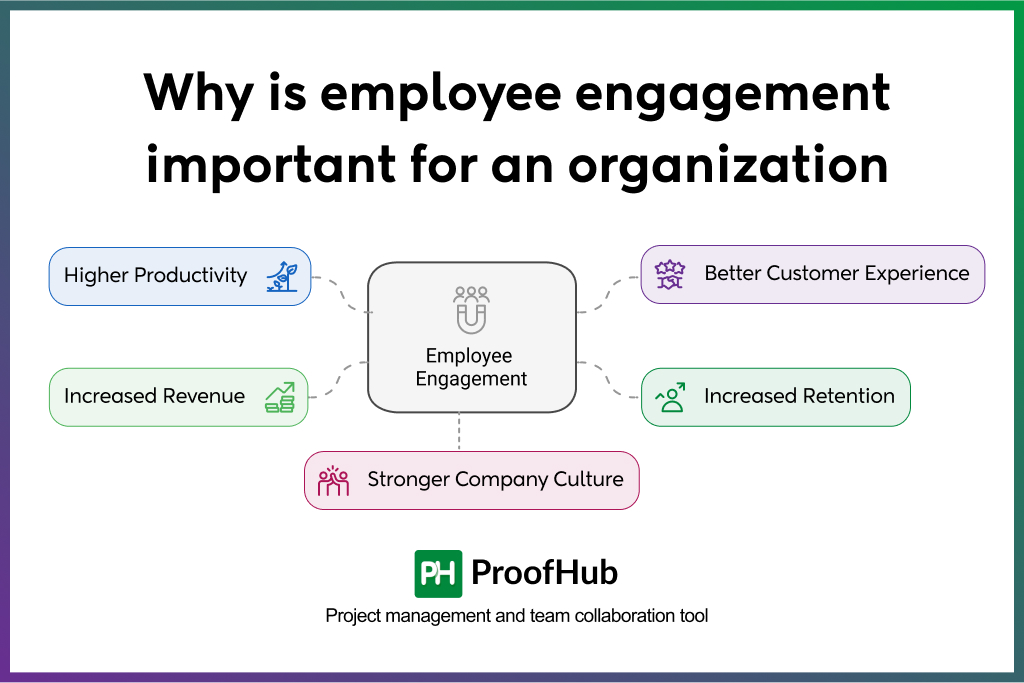
Here are some key benefits of prioritizing employee engagement in your organization:
- Higher productivity
According to Gallup’s Employee Engagement & Experience statistics, organizations with highly engaged workforces witness 18% higher productivity compared to less engaged teams.
This shows that when employees feel deeply invested in their work and the company’s mission, they go the extra mile to constantly deliver—not just acceptable work but the best work. They are self-driven and find a great sense of ownership in their work.
This leads to better efficiency and overall outcomes.
- Better customer experience
Employees who are more committed to their roles and the organization extend the same dedication to delivering exceptional customer experiences.
Denise Lee Yohn, a keynote speaker substantiates the fact in the Harvard Business Review saying,” I believe it’s time for leaders to double down on the idea that EX is now the key driver of CX and to find smarter, strategic ways of connecting the two.” (EX = Employee Experience, CX = Customer Experience)
This engagement-driven approach transforms employees into brand ambassadors—the faces of the organization—whom customers trust and rely on.
- Increased retention
The level of employee engagement directly impacts their commitment and longevity in the organization. As Danny Nelms, the CEO of Work Institute, puts it,
“The retention and engagement of employees has never been more important.”
Employees who are content and engaged in their roles are 87% less likely to leave their organization. This means your human resource team spends less time recruiting replacements and more time developing and nurturing existing talent.
- Increased revenue and profits
While many leaders perceive engagement as an abstract concept, the reality is quite the opposite.
When employees feel connected to their work, they don’t run away from responsibilities; instead, they uncover new revenue opportunities for organizations. They are not merely present but productive, proactive, and profit-driven.
Also, engaged teamwork as a unit to outperform competitors. Research confirms that highly engaged companies see a 23% boost in profitability, leading to tangible benefits.
- Stronger company culture
Culture isn’t built through fancy mission statements and corporate slogans. Instead, when teams share common values, collaborate effectively, and support one another, it greatly impacts organizational culture.
With this, a disengaged office transforms into a more motivating, dynamic, and inspiring workplace where employees are proud to be a part of something bigger than themselves.
In the end, it is a business strategy that puts people first and shapes the company from within.
Create a high-performance culture to keep teams engaged and motivated
Who is responsible for employee engagement?
Boosting employee motivation and engagement is not a solo act but a collective effort – one that thrives when every level of the organization commits to it.
If your employees are unhappy with their jobs, it will undoubtedly show in their work. They may clock in and complete tasks, but that extra effort that brings excellence will remain out of reach.
Here is how everyone contributes to employee engagement:
- Leaders set the vision: Many believe that engagement is merely HR’s responsibility, but the reality is that leaders are the key players in shaping and sustaining it. Remember, engagement is not a policy rollout; it thrives naturally when leaders model behaviors and embody company values consistently.
By setting a compelling vision, promoting transparency, and prioritizing employee well-being, leaders inspire teams to stay engaged and invested.
- Managers create the environment: Managers have the most direct impact on the day-to-day engagement of employees and how they feel motivated, valued, and connected with their work.
Providing autonomy so employees take ownership, encouraging psychological safety where ideas and concerns are welcomed, and delivering continuous feedback for growth opportunities are essential practices that make a huge difference in how employees connect with their work and the organization.
- Employees shape the culture: Employees are the heart and soul of an organization. While leaders and managers lay the foundation, engagement ultimately depends on how employees interact, collaborate, and contribute.
When a workplace prioritizes trust, inclusivity, and empowerment, employees feel a sense of belonging, trust, and purpose. As a result, engagement becomes contagious where teams collaborate better, morale rises, and innovation flourishes.
- HR facilitates support systems: HR professionals are key in enabling and sustaining employee engagement. They do not own engagement alone but equip managers and teams with the right tools, policies, and real-time insights to foster engagement effectively.
From designing employee well-being initiatives to ensuring a balance between company policies and employee expectations, HR serves as the strategic bridge between leadership vision and workforce needs.
What is the role of leadership in employee engagement?
While all the organization levels significantly contribute to facilitating employee engagement, leadership remains the key driving force.
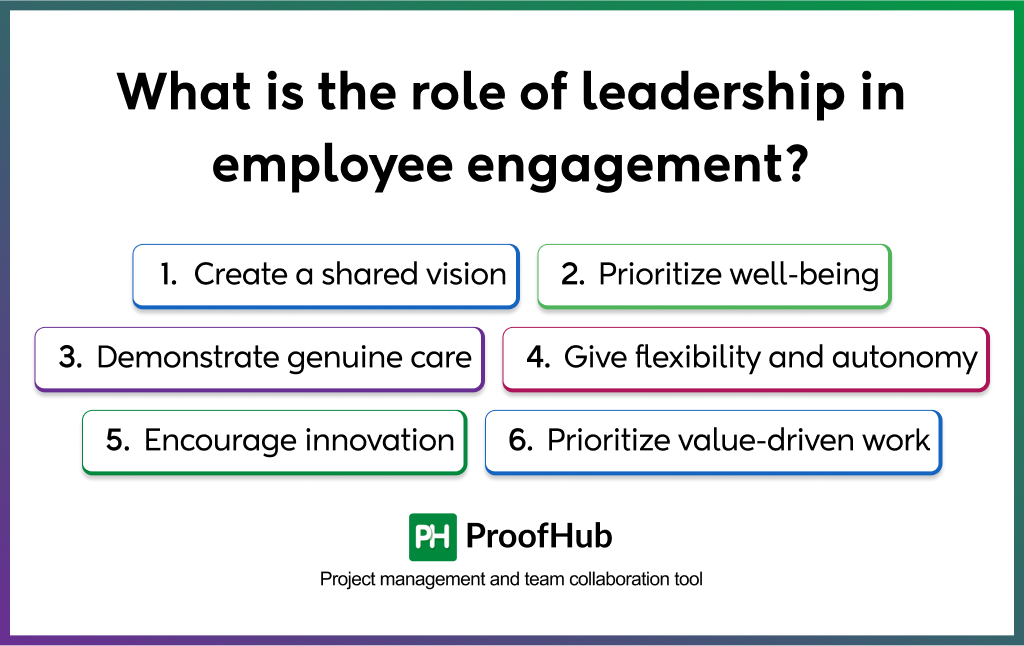
The way leaders articulate goals and expectations, build relationships, and create a supportive environment directly shapes employee experiences.
- Create a shared vision: Engage employees by co-creating a vision that they buy into. When they know the significance of their daily work, they feel a stronger sense of purpose, commitment, and ownership.
- Prioritize well-being: Gallup’s 2024 State of the Global Workforce report states that 41% of employees feel a direct link between daily stress and work experiences. Leaders can reduce this number by keeping a proactive check on employee well-being. Promote mental health initiatives, encourage work-life balance, and ensure a supportive culture to strengthen overall organizational health.
- Demonstrate genuine care: Authentic leadership demonstrates real care for the people who bring the company’s vision to reality. By actively supporting employees in both personal and professional growth, you can build long-term engagement.
- Give flexibility and autonomy: True engagement never comes from control; it comes from trust and empowerment. To maximize productivity and satisfaction, give employees the flexibility to work in ways that best suit their style, preferences, and peak performance hours.
- Encourage innovation: Employees feel more engaged and motivated when they aren’t afraid of criticism and feel safe to experiment. In fact, when given autonomy, they feel more inspired to bring fresh ideas and drive exceptional results.
- Prioritize value-driven work: Clarify performance benchmarks and the impact of each role from the very beginning. When employees understand expectations, recognize the significance of their contributions, and see how their work aligns with the broader vision, they are more driven to excel.
Strategies for improving employee engagement
Although changing every employee’s attitude and perspective towards work may seem difficult, influencing engagement doesn’t have to be a laborious process. Small, intentional initiatives can add up to make a massive difference.
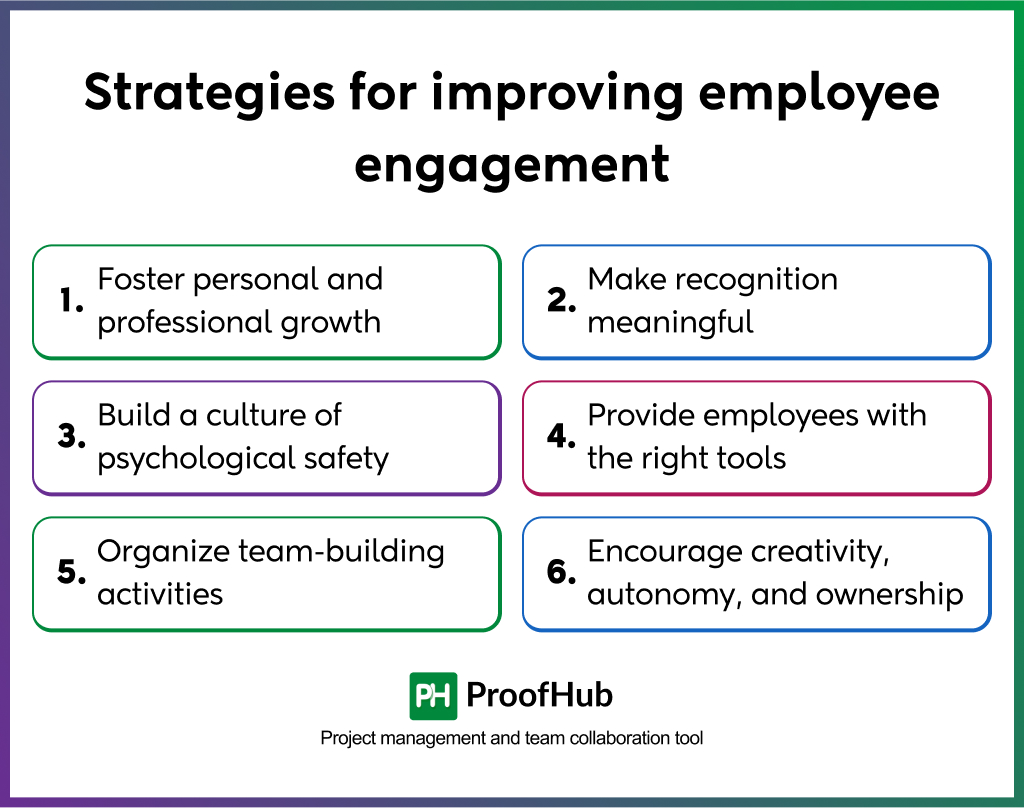
Here are some structural changes you can implement to drive meaningful engagement:
1. Foster personal and professional growth
Professional growth is crucial, but so is personal. While employers often expect employees to leave their personal challenges at the door, these can take a huge toll on productivity and overall business performance.
On the contrary, understanding your employees outside the work allows you to create a harmonious balance between their professional and personal growth.
To truly support your team’s growth, don’t just manage them – know them. Learn about their interests, passions, and aspirations beyond the workplace. Give them the resources and flexibility to grow in ways that best align with their interest.
2. Make recognition meaningful and personalized
Recognizing employees for their hard work is a powerful motivator that inspires loyalty and commitment.
However, just as a lack of recognition can diminish morale, generic or insincere appreciation can feel. If employees feel unseen, or if recognition is given merely as a formality, it loses its impact. In fact, it creates a negative domino effect, dropping their willingness to go the extra mile.
To avoid this, make sure that you are recognizing, rewarding, and appreciating your team for their hard work, not in a generic, but meaningful and personalized way.
To make recognition truly meaningful:
- Avoid generic, one-size-fits-all acknowledgments. Tailor it for individual contributions.
- Go beyond titles like “Employee of the Month.” Instead, personalize recognition based on achievements, such as:
Generic: “Employee of the Month” award.
Personalized: A handwritten note, verbal recognition, or monetary benefits, acknowledging a specific project impact.
By making recognition personal, timely, and relevant, you can let team members know how much you appreciate their work.
Also read: 25 employee recognition ideas to appreciate your team’s hard work
3. Build a culture of psychological safety
Employees struggle when their every move is met with criticism. If you keep on calling out their mistakes publicly or humiliating them for their mistakes, then be assured that no one will willingly come forward to explore something new.
If you want a culture of innovation and engagement, create a psychologically safe environment where employees don’t fear backlash. Don’t shut down ideas or dismiss them without consideration. Instead, listen, provide constructive feedback, and refine them together.
Additionally, in the case of setbacks or failures, conduct “failure retrospectives” rather than assigning blame. This helps teams analyze what went wrong, extract key learnings, and develop better strategies.
4. Provide employees with the right tools and resources
Employees struggle when they lack the right tools and resources at their disposal. Outdated systems that fail to keep up with modern business demands can lead to inefficiencies and a decline in productivity.
On the other hand, equipping employees with the right technology empowers them to work smarter, collaborate effectively, and stay engaged.
For example, having an efficient, all-in-one solution like ProofHub gives employees more control over how they work and bring results. By bringing all work-related conversations, files, documents, and tasks into one place, ProofHub helps teams streamline task management, centralize communication, and eliminate confusion.
Also, it eliminates the frustration and confusion that comes with scattered workflows and communication silos, keeping everyone on the same page.
4. Organize team-building activities and events
Social connection is one of the most crucial drivers of employee engagement. Organizations often introduce team-building activities to maintain the sync between them. However, forced team interactions can feel superficial and may even backfire.
Instead of making team bonding feel like an obligation, shape it to be more intentional and engaging to create a fun environment at work.
- Create interest-based communities – allow employees to connect over shared hobbies.
- Encourage spontaneous interactions – host casual coffee meetups, office happy hours, or outdoor activities.
- Celebrate together – organize events, festive celebrations, team lunches, or even office trips.
These sessions allow employees to socialize and form real connections in the workplace.
5. Encourage creativity, autonomy, and ownership
Employees disengage when forced to follow a rigorously, overly structured workflow. Their creativity and problem-solving ability become stifled, making them feel uninspired and restricted.
You must let your team members’ freedom to explore their creative side, challenge norms, and experiment with new approaches. This allows them to add their unique touch, even to routine, monotonous tasks.
By giving them autonomy to work in their own way, employees develop a strong sense of ownership over their tasks. This contributes to their engagement and professional development, pushing them to think outside the box.
What factors affect employee engagement
To increase employee engagement levels, you must first understand the factors that directly or indirectly influence them. Some key elements include:
- Career development: Organizations that invest in employees’ career growth – providing opportunities and training for skill development, continuous learning, and professional advancement – tend to create happier and more engaged workforces. Employees are more loyal and motivated when they see a clear direction for growth.
- Autonomy: Employees excel when given the freedom to work independently, make decisions, and shape their own workflows. Excessive control, constant dictation, and rigid hierarchies stifle creativity and motivation. When employers give employees the space to take ownership, they often exceed expectations and deliver exceptional results.
- Empowerment: A culture of trust and support empowers employees to take initiative and contribute meaningfully. When employees feel hesitant or uncertain, engagement suffers. As a leader, you must create an environment where employees feel encouraged to voice opinions and take calculated risks.
- Sense of purpose: Employees who find meaning in their work are far more invested and engaged. Instead of assuming that a company’s mission will naturally inspire employees, leaders should actively connect with employees, showing them how their contributions make a difference. This promotes deeper commitment and motivation.
- Work-life balance expectations: Maintaining a balance between work and personal life is a growing concern, especially in remote and hybrid work environments. Employees who feel constantly pulled between personal and professional commitments are more likely to feel stressed and disengaged. You can build a productive workforce on every front by providing them flexibility and respecting their boundaries.
Read more: 13 Proven work-life balance tips for overworked professionals
- The role of AI and automation: The rise of AI has transformed into growing concerns among employees, replacing human jobs and making work impersonal. Organizations must intentionally ease the tension by communicating that AI is an enabler and not a replacement. It is here to enhance and help – not replace – human efforts, preparing a future-ready workforce.
How to measure employee engagement?
Measuring employee engagement isn’t about keeping a constant check on employees’ every move to micromanage—it’s about getting real-time insights to take proactive actions before things worsen for the organization and its people.
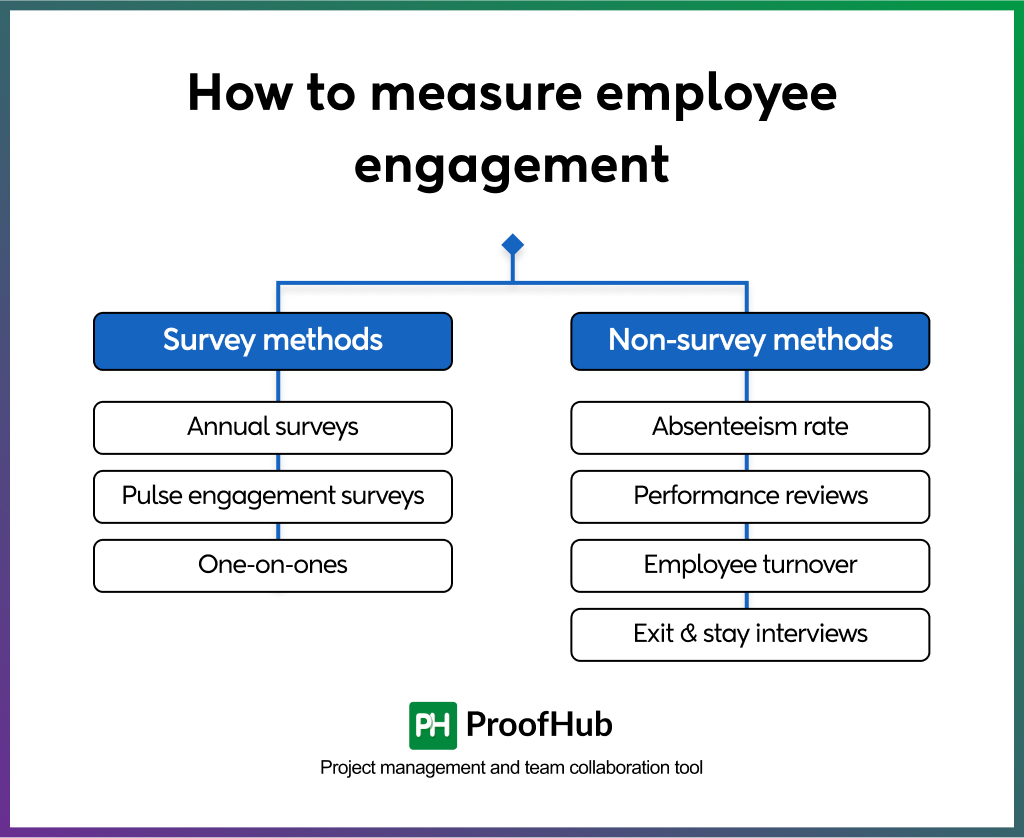
There are two major methods of measuring engagement. While you can choose either of the approaches, I would suggest using a mix of both, so that you get a well-rounded perspective.
- Survey methods
- Non-survey methods
Survey methods
- Annual surveys
As the name suggests, this method assesses employees’ motivation and passion toward the organization after an interval of a year. While it brings a big-picture view, the approach falls short in certain cases.
I find it to be a dated practice, as the insights often become obsolete when results are analysed. The corrective measures taken in order to fix engagement issues fail to make a real impact.
Once-a-year surveys, however, still work for many organizations that use them alongside more frequent check-ins.
- Pulse engagement surveys
Employee pulse surveys are conducted frequently and help gauge real-time sentiments.
These quick check-ins help you capture employee concerns and engagement trends early to act swiftly.
Not only this, but by the time you conduct your next survey, you can track the effectiveness of the previously implemented actions.
- One-on-ones
1:1 or personalized check-ins, from my perspective, are a relevant engagement practice even today. It is a structured and intentional approach that allows managers to have meaningful conversations and address individual concerns proactively.
This practice provides a safe space for employees to raise their concerns, issues, and ideas, reinforcing that their opinions are heard and valued.
Also, by analyzing tones and expressions, you can even analyze the truth in their words, uncovering hidden challenges that employees might hesitate to bring otherwise.
Non-survey methods
- Absenteeism rate
This metric considers repeated unplanned absences that often come unannounced, contrary to the occasional and legitimate absences.
Not only does it signal disengagement, but it also impacts the productivity of other co-workers, stagnating the flow of work. For example, if employees frequently call in sick or take sudden leaves for urgent work, it may indicate burnout or dissatisfaction.
- Performance reviews & feedback
Whether formal or informal, employee performance is a strong reflection of their engagement.
If employees are constantly underperforming or putting in the bare minimum effort, chances are the problem may not be skill-based but a lack of motivation and purpose.
Managers should hold regular performance discussions to provide constructive feedback and suggestions for improvement. By doing this, you can track patterns and behaviors to analyze engagement trends since the last feedback session.
Read more: Constructive feedback: Why it is important and how to give it
- Employee turnover
Employees don’t just leave for higher paychecks or better job titles. In fact, sometimes, it is a toxic or unengaging work culture that fails to keep employees committed for the long run.
Also, several other potential reasons lead to high turnover— lack of recognition, poor leadership, work overload, misalignment with company values, or lack of career growth opportunities—factors that influence employee retention and engagement.
- Exit & stay interviews
Exit interviews are structured discussions conducted when an employee leaves the organization. They offer substantial information about their experiences in the company, bringing insights into why they decided to leave initially.
Also, these sessions give organizations an opportunity to improve policies and workplace culture. While these have their own value, I find stay interviews more impactful.
Instead of waiting for an employee’s resignation, you can use these to identify engagement gaps before they become reasons for leaving. The major goal should be to retain valuable contributors before they slip away.
Fun survey questions to ask for increasing employee engagement
To promote employee engagement in your organization, you must go beyond practicing traditional HR practices and conduct interactive sessions to get valuable insights in a fun way.
Here are some engaging survey questions to ask your employees:
Workplace satisfaction
- Which TV show reminds you of your job?
- How do you feel about coming to work with ‘Monday blues’?
- Which one GIF or meme best describes your job?
Team & collaboration
- If you could swap jobs with a teammate for a day, who would it be and why?
- What’s the funniest/most memorable moment you’ve had with your colleagues?
- Who is your support system at work?
Recognition & motivation
- Who has always got your back at work?
- What are the creative ways to be recognized at work?
- What is one element at work that keeps you going?
Workplace improvements
- What’s the one thing you’d change about work?
- What’s the one snack or drink you wish we had unlimited access to in the office?
- Would you recommend a job for your friend in your office? Why or why not?
What are the 5 c’s of employee engagement?
The 5 core principles of employee engagement inspire commitment and motivation. These help create a thriving environment where employees feel valued, supported, and empowered to perform at their best.
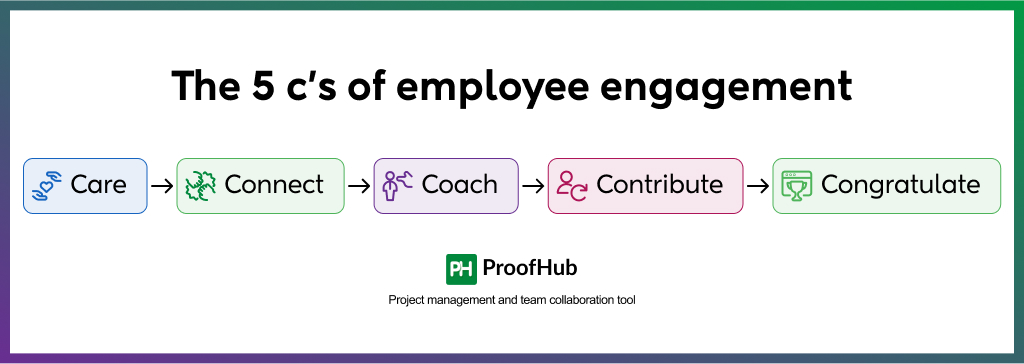
1. Care
“Without a sense of caring, there can be no sense of community.” – Anthony J. D’Angelo
I can confirm from my experience as well that caring goes beyond providing surface-level perks. When employees see you genuinely prioritize and care about their emotional and existential needs, beyond corporate norms and policies, they feel safe to express their vulnerabilities and share their personal struggles.
Be it supporting their mental health, promoting physical health initiatives, or merely offering work-life balance by providing flexibility, these small but significant gestures help employees feel a deeper sense of belonging and fulfillment.
Pro tip: Practice radical empathy to respond thoughtfully and meaningfully.
2. Connect
“Connection and teamwork are very much intertwined. If you can’t connect with a person, be a team player. If a person does not show teamwork, connect with them. All engagement is centered around relationships.” — Janna Cachola
Building strong relationships with teams is a powerful way to make teams more committed and engaged. While leaders often leave employee bonding to HRs, occasional team-building activities or forced interactions don’t create deep, meaningful relationships. The real challenge is creating authentic connections.
While prioritizing effective communication and establishing open channels definitely help, creating a psychologically safe environment and practicing intentional inclusion practices are equally vital. This approach helps build strong bonds and create a culture of effective collaboration.
Explore the list of 13 best internal communication tools to connect employees
3. Coach
“Coaching is unlocking a person’s potential to maximize their own performance. It is helping them to learn rather than teaching them.” – Timothy Gallwey
Effective coaching is not about dictating but empowering teams to grow, learn, and take ownership. Setting clear goals, providing regular feedback, and hosting training sessions are some methods to develop employees’ skills and confidence.
Also, you can conduct peer-to-peer mentorship for employees to learn from each other’s experience and expertise. However, knowing when to step in and when to give employees the space for autonomy is one balancing act that you as a leader must master.
4. Contribute
“You get the best out of others when you give the best of yourself.” – Harvey S. Firestone
Encouraging employees to contribute their thoughts, suggestions, and ideas is one of the most effective ways to promote engagement. It empowers employees to take the lead, raise their ideas and concerns, or challenge the norm, making them feel more accountable for their responsibilities.
This sense of ownership comes from intentional leadership and a culture of trust. Leaders must connect their individual goals to the broader organization’s vision and mission for a stronger sense of purpose.
5. Congratulate
“Recognition is the greatest motivator.” – Gerard C. Eakedale
Recognizing and appreciating a job well done, an achievement, or even the efforts amongst peers and teams, reinforces a feeling of motivation and pride in employee behaviors, driving continued engagement.
While recognition comes across as transformational, the timing, authenticity, and personalization present a measure of its true impact. Because generic or delayed recognition does the opposite, making the gesture look hollow and ineffective. This small yet powerful action can make or break long-term employee morale.
Pro tip: You can make company-wide announcements using ProofHub to celebrate and recognize achievements and accomplishments.
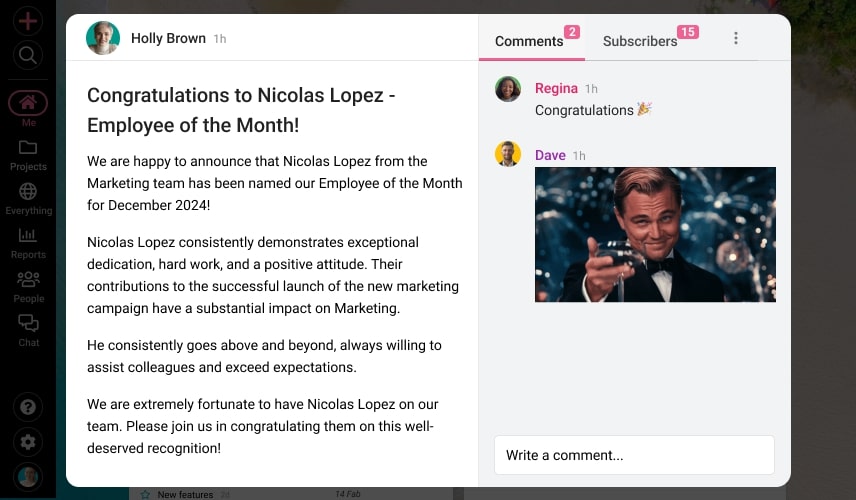
Conclusion
Long story short, employee engagement is a dynamic and evolving concept.
It requires more than surface-level initiatives from leaders and managers – it is about instilling employees with a deep sense of motivation and purpose.
From asking fun and interactive questions to creating a psychologically safe environment, these employee engagement strategies enhance workplace productivity, drive profitability, and strengthen your company’s reputation.
Additionally, using technological solutions like ProofHub helps drive engagement in a more structured yet flexible way. With features like announcements, discussions, group chat, and task management, ProofHub creates a more connected and self-driven workforce.
You can sign up for its 14-day free trial to experience employee engagement firsthand.
Frequently asked questions
What one action can leaders take to improve employee engagement?
One powerful action leaders can take to improve employee engagement is promoting a psychological safety culture. Employees must feel comfortable voicing ideas, taking risks, and experimenting without fearing failure, criticism, or repercussions. When this safety is compromised, confidence and performance suffer.
How does employee engagement affect retention?
Engaged employees are more likely to stay committed for longer when they feel valued, motivated, and connected to the work. When employees find fulfillment in their roles, they are less likely to seek opportunities elsewhere, reducing turnover and saving companies costs on hiring and training.
What is the difference between employee engagement and motivation?
Employee engagement is long-term emotional and mental commitment to one’s work and organization, while motivation is a short-term drive to complete tasks or achieve specific goals. Where motivation can be influenced by external factors (bonuses, promotions) or internal ones(personal growth, purpose), engagement is a much deeper feeling reflecting overall dedication and connection to the workplace.

